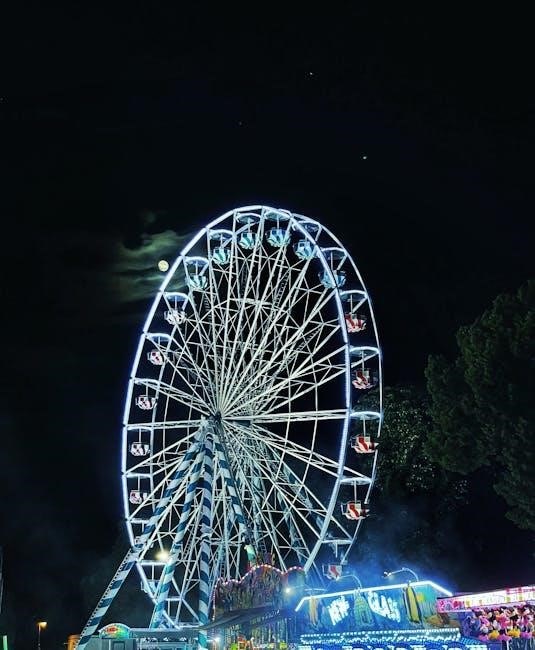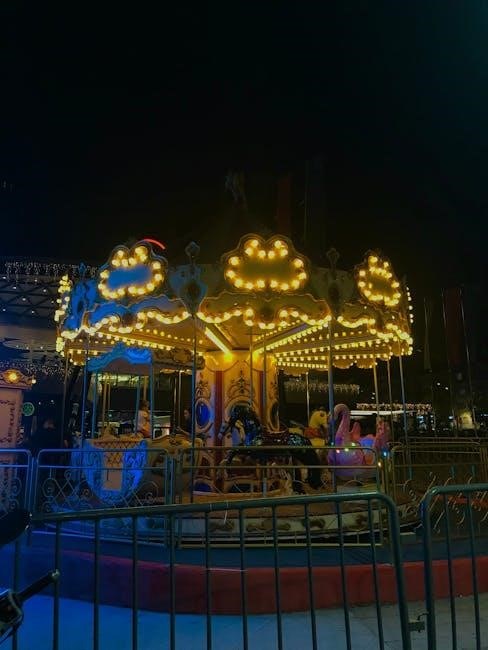This iconic narrative poem by Henry Wadsworth Longfellow, written in 1860, vividly captures the urgency of Paul Revere’s historic midnight ride, preserving its legacy in American literature.
Overview of the Poem and Its Historical Context
Henry Wadsworth Longfellow’s The Midnight Ride of Paul Revere is a narrative poem that dramatizes the historic event of Paul Revere’s midnight ride on April 18, 1775. The poem captures the urgency and patriotism of the moment, as Revere and other messengers raced to warn colonial forces of the approaching British troops. Set against the backdrop of the American Revolution, the poem immortalizes Revere’s role in the Battles of Lexington and Concord, which marked the start of the war. Longfellow’s vivid storytelling and rhythmic verse bring to life the tension and courage of the era, blending historical fact with poetic imagination. The poem has become a cultural symbol of American independence and resilience, enduring as a beloved classic in American literature.
The Author: Henry Wadsworth Longfellow
Henry Wadsworth Longfellow is the celebrated American poet and educator behind the iconic 1860 poem, which has left a lasting cultural mark.

Biography of Henry Wadsworth Longfellow
Henry Wadsworth Longfellow, born on February 27, 1807, in Portland, Maine, was a prominent American poet and educator. He came from a literary family and showed early academic promise. Longfellow studied at Bowdoin College, where he later taught modern languages. His travels in Europe influenced his writing style, blending romanticism with American themes. Known for his lyrical and accessible poetry, he became a beloved figure in American literature. His works, including “The Midnight Ride of Paul Revere,” have endured as timeless classics, reflecting his deep appreciation for history and culture.
Longfellow’s Contribution to American Literature
Henry Wadsworth Longfellow was a pivotal figure in American literature, celebrated for his lyrical and accessible poetry that captivated a broad audience. His works, such as The Midnight Ride of Paul Revere, Evangeline, and The Song of Hiawatha, bridged European romanticism with American themes, fostering a national identity. Longfellow was the first American to translate Dante’s Divine Comedy, showcasing his scholarly depth. His poetry often emphasized history, folklore, and emotional depth, making it relatable and enduring. By blending tradition with innovation, Longfellow helped establish a distinct American literary voice, leaving a lasting legacy that continues to inspire readers and writers alike.

The Midnight Ride of Paul Revere: Historical Background
The Midnight Ride occurred on April 18, 1775, as Paul Revere warned colonists of the approaching British army, sparking the Battles of Lexington and Concord.
The Events Leading to the Midnight Ride
Tensions between British authorities and American colonists escalated in 1775, with the British planning to seize colonial arms in Concord. Patriots, led by figures like Joseph Warren, organized a warning system to alert the countryside of British movements. Paul Revere and William Dawes were tasked with delivering critical intelligence, as British troops under General Gage prepared to march on April 18, 1775. The famous “one if by land, two if by sea” signal, displayed through lanterns in the Old North Church steeple, was devised to warn of the British approach. This strategic preparation set the stage for Revere’s historic ride, ensuring the colonists were ready to defend themselves against the impending British invasion.
Paul Revere’s Role in the American Revolution
Paul Revere was a pivotal figure in the American Revolution, serving not only as a messenger but also as a leader and symbol of patriotism. Beyond his midnight ride, Revere contributed as a silversmith, engraver, and soldier, producing propaganda to galvanize colonial resistance. His role in the Sons of Liberty and participation in key events, such as the Boston Tea Party, highlighted his commitment to the cause. Revere’s leadership extended to commanding a militia regiment, showcasing his multifaceted contributions to the fight for independence. His bravery and strategic thinking made him an enduring emblem of American determination and unity during the Revolution.

The Poem’s Structure and Style
H.W. Longfellow’s narrative poem, published in 1860, features a rhythmic and rhyming style, enhancing its storytelling appeal with a patriotic tone and historical significance.
Analysis of the Poem’s Rhyme and Meter
The poem follows a consistent trochaic meter, enhancing its rhythmic and narrative flow. Longfellow employs an ABAB rhyme scheme, creating a musical quality that captivates readers. The meter mimics the galloping rhythm of a horse, mirroring Paul Revere’s urgent ride. Rhyming couplets at the end of each stanza add to the poem’s lyrical appeal, making it memorable and engaging. The dactylic meter in certain lines adds a sense of urgency, reflecting the tension of the historical moment. These literary devices not only convey the story effectively but also elevate its emotional impact, ensuring the poem’s enduring popularity as a masterful blend of form and function.
Key Themes and Symbolism in the Poem
The poem explores themes of patriotism, bravery, and freedom, highlighting Paul Revere’s role as a symbol of American resilience; The midnight ride itself symbolizes urgency and the call to action against oppression. The lanterns in the Old North Church represent communication and strategy, emphasizing the importance of unity in the face of adversity. Revere’s journey through the night embodies courage and determination, while the British invasion symbolizes the threat to colonial autonomy. The poem also underscores the power of individual actions in shaping history, inspiring collective resistance. Through these themes, Longfellow crafts a narrative that not only commemorates a historical event but also celebrates the spirit of revolution and the pursuit of liberty.
Significant Excerpts and Their Meanings
“Listen, my children, and you shall hear” sets the tone, engaging readers with history. “The British are coming!” symbolizes alarm and urgency, driving the narrative’s tension and purpose.
Famous Lines from the Poem and Their Impact
The poem’s opening line, “Listen, my children, and you shall hear,” captivates readers, drawing them into the historic narrative. Another iconic line, “The British are coming!”, though historically inaccurate, has become a symbol of urgency and patriotism. These phrases, crafted by Longfellow, not only highlight Paul Revere’s bravery but also immortalize the spirit of the American Revolution. The lines have resonated deeply, shaping popular perception of the event and cementing the poem’s place in cultural memory. Their rhythmic and evocative nature has made them unforgettable, ensuring the poem’s enduring relevance and impact on American heritage.

Historical Accuracy vs. Poetic License
Longfellow’s poem blends fact with artistic license, exaggerating Paul Revere’s role for dramatic effect while omitting others like William Dawes, creating a legendary yet partially fictional account.
How the Poem Differs from Historical Records
Longfellow’s poem creative departs from historical facts, portraying Paul Revere as the sole rider shouting “The British are coming!” In reality, Revere was accompanied by William Dawes and Samuel Prescott, with Prescott completing the ride to Concord. Additionally, the poem exaggerates the number of British soldiers, stating “two thousand,” while records indicate far fewer. Historically, the operation was covert, with whispers rather than shouts. The poem also omits the broader context of colonial resistance, focusing solely on Revere’s heroism. These artistic liberties enhance the narrative’s drama, creating a legendary figure while simplifying the complexities of the actual event.

The Legacy of the Poem
Longfellow’s poem became a cornerstone of American literature, celebrated for its vivid storytelling and patriotic themes, shaping national identity and enduring as a cultural symbol of courage and freedom.
The Poem’s Influence on American Culture
Henry Wadsworth Longfellow’s The Midnight Ride of Paul Revere has profoundly shaped American cultural identity. Its vivid portrayal of patriotism and bravery inspired national pride, making it a cornerstone of U.S. heritage. The poem’s rhythmic and memorable language has been widely taught in schools, ensuring its enduring popularity. It has also influenced art, media, and literature, with references appearing in films, music, and historical reenactments. Longfellow’s work not only immortalized Paul Revere but also cemented the midnight ride as a symbol of American resistance and freedom. Its legacy continues to resonate, fostering a deep connection to the nation’s revolutionary past and its values.

Paul Revere’s Ride in Modern Times
The poem remains a cultural touchstone, frequently referenced in media, education, and popular culture, ensuring its enduring relevance and inspiration for new generations.
The Enduring Popularity of the Poem
Henry Wadsworth Longfellow’s The Midnight Ride of Paul Revere remains a beloved piece of American literature, celebrated for its vivid storytelling and historical significance. Its rhythmic verse and patriotic themes continue to captivate readers, making it a staple in classrooms and cultural discussions. The poem’s ability to blend history with poetic flair has ensured its relevance across generations. Its availability in the public domain and online formats, such as PDFs, has further amplified its accessibility. Schools often use the poem to teach American history and literary techniques, while its imagery and phrases, like “the British are coming,” have become part of the national lexicon. This timeless work continues to inspire new adaptations and interpretations, solidifying its place in cultural memory.
The Midnight Ride of Paul Revere remains a timeless piece of American literature, celebrating patriotism and history through its enduring verses, ensuring its lasting cultural and historical significance.
Final Thoughts on the Poem’s Significance
The Midnight Ride of Paul Revere holds profound significance as a cultural and historical artifact. Longfellow’s masterful storytelling transformed a pivotal revolutionary event into a legendary tale, embedding it deeply within American consciousness. The poem’s vivid imagery and rhythmic verse have made it accessible and memorable, ensuring its enduring popularity. Beyond its literary merit, it serves as a testament to the spirit of patriotism and resilience that defined the American Revolution. While some historical details may be romanticized, the poem’s core message of courage and unity remains timeless, continuing to inspire generations and solidify Paul Revere’s place in American folklore.